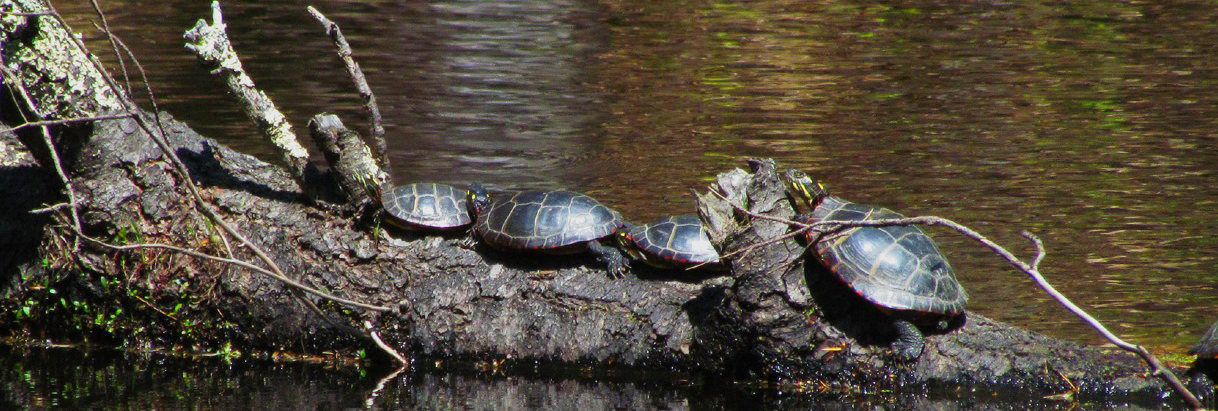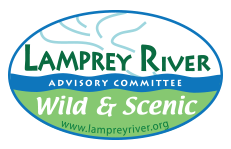NH Science Standards
Specific standards annotations appear following Lesson 7.
Lesson 1: The River Runs Wild and Scenic
Science Process Skills: S:SPS1:4:1.7, S:SPS1:4:1.8, S:SPS3:4:1.2, S:SPS3:4:2.4, S:SPS4:4:1.1, S:SPS4:4:3.3
Earth Space Science: S:ESS1:4:7.2, S:ESS4:4:3.1, S:ESS4:4:3.2, S:ESS4:4:3.3
Life Science: S:LS2:4:1.1, S:LS2:4:1.2, S:LS3:4:1.1, S:LS3:4:1.3, S:LS3:4:3.2,
Physical Science: S:PS4:4:3.2
Lesson 2: The River Flows Through Life
Science Process Skills: S:SPS1:4:1.7, S:SPS1:4:1.8, S:SPS3:4:1.2, S:SPS3:4:2.4, S:SPS4:4:1.1, S:SPS4:4:7.1
Physical Science: S:PS4:4:3.1, S:PS4:4:3.2
Lesson 3: A Map of Our Own
Science Process Skills: S:SPS3:4:1.2 , S:SPS3:4:2.6, S:SPS4:4:5.1
Lesson 4: Field Trip: Stopping Along the Lamprey
Science Process Skills: S:SPS1:4:1.1, S:SPS1:4:1.2, S:SPS1:4:1.4, S:SPS1:4:1.7, S:SPS1:4:3.1, S:SPS1:4:3.2, S:SPS1:4:3.3, S:SPS1:4:4.1, S:SPS1:4:4.2, S:SPS1:4:4.3, S:SPS1:4:4.4, S:SPS1:4:5.1, S:SPS1:4:5.2, S:SPS1:4:5.3, S:SPS2:4:1.1, S:SPS2:4:1.2, S:SPS2:4:1.3, S:SPS2:4:1.4, S:SPS2:4:1.5, S:SPS2:4:3.1, S:SPS2:4:3.2, S:SPS3:4:1.1, S:SPS3:4:1.2, S:SPS3:4:2.4, S:SPS3:4:2.5, S:SPS3:4:2.6, S:SPS3:4:2.7, S:SPS4:4:1.1, S:SPS4:4:1.2, S:SPS4:4:3.3, S:SPS4:4:4.2, S:SPS4:4:4.3, S:SPS4:4:6.2, S:SPS4:4:7.1
Earth and Space Science: S:ESS1:4:5.1, S:ESS1:4:5.2, S:ESS1:4:6.4, S:ESS4:4:1.1, S:ESS4:4:3.2
Life Science: S:LS1:4:2.1, S:LS1:4:2.3, S:LS1:4:2.4, S:LS2:4:1.1, S:LS2:4:1.2, S:LS2:4:2.2, S:LS2:4:3.1, S:LS2:4:3.2, S:LS3:4:1:1, S:LS3:4:1.3, S:LS3:4:3.2, S:LS5:4:2.1
Physical Science: S:PS2:4:1.1, S:PS2:4:3.8, S:PS3:4:2.1, S:PS4:4:2.1
Lesson 5a: Examining the River Data
Science Process Skills: S:SPS1:4:1.4, S:SPS1:4:1.7, S:SPS1:4:1.8, S:SPS1:4:4.1, S:SPS1:4:4.2, S:SPS1:4:4.3, S:SPS1:4:4.4, S:SPS1:4:5.1, S:SPS1:4:5.2, S:SPS1:4:5.3, S:SPS2:4:1.1, S:SPS2:4:1.2, S:SPS2:4:1.3, S:SPS2:4:1.4, S:SPS2:4:1.5, S:SPS2:4:3.1, S:SPS2:4:3.2, S:SPS2:4:4.1, S:SPS2:4:4.3, S:SPS3:4:1.1, S:SPS3:4:1.2, S:SPS3:4:2.4, S:SPS3:4:2.5, S:SPS3:4:2.6, S:SPS3:4:2.7, S:SPS4:4:2.1, S:SPS4:4:3.3, S:SPS4:4:4.2, S:SPS4:4:4.3, S:SPS4:4:6.2, S:SPS4:4:7.1
Earth and Space Science: S:ESS4:4:3.2, S:ESS4:4:3.3
Life Science: S:LS1:4:2.4, S:LS2:4:1.2, S:LS3:4:1.3, S:LS3:4:3.2
Physical Science: S:PS2:4:1.1, S:PS2:4:3.8, S:PS3:4:2.1
Lesson 5b: Using the Data
Science Process Skills: S:SPS1:4:1.1, S:SPS1:4:1.2, S:SPS1:4:1.7, S:SPS1:4:3.1, S:SPS1:4:3.3, S:SPS1:4:4.1, S:SPS2:4:3.2, S:SPS3:4:1.2, S:SPS3:4:2.4, S:SPS3:4:2.5, S:SPS4:4:1.1, S:SPS4:4:1.2, S:SPS4:4:3.3, S:SPS4:4:4.2, S:SPS4:4:5.1, S:SPS4:4:6.2, S:SPS4:4:7.1
Life Science: S:LS1:4:2.1, S:LS2:4:1.1, S:LS2:4:2.1, S:LS2:4:2.2, S:LS3:4:1:1, S:LS3:4:1.3, S:LS5:4:1.1, S:LS5:4:2.1
Physical Science: S:PS4:4:2.1
Lesson 6: People of the River
Science Process Skills: S:SPS3:4:1.2
Earth and Space Science: S:ESS4:4:3.2
Physical Science: S:PS4:4:3.1, S:PS4:4:3.2
Lesson 7: A Message to the Lamprey River
Science Process Skills: S:SPS1:4:1.7, S:SPS1:4:4.1, S:SPS1:4:5.3, S:SPS3:4:1.2, S:SPS4:4:2.1, S:SPS4:4:4.3, S:SPS4:4:5.1, S:SPS4:4:7.1
Earth and Space Science: S:ESS4:4:3.2
Life Science: S:LS2:4:1.1, S:LS3:4:1.1, S:LS3:4:1.3
Physical Science: S:PS4:4:3.1, S:PS4:4:3.2
Science Literacy New Hampshire Curriculum Framework
(Relevant sections of the Science Literacy Framework are listed here.)
Science Process Skills
By the end of Grade 4, all students will apply skills from previous grades and…
SPS1– Scientific Inquiry and Critical Thinking Skills (INQ)
1. MAKING OBSERVATIONS AND ASKING QUESTIONS
S:SPS1:4:1.1 Extend the senses using simple tools.
S:SPS1:4:1.2 Make and record observations for a given purpose.
S:SPS1:4:1.4 Record observations using standard units of measurement.
S:SPS1:4:1.7 Ask questions about objects, organisms and events in their local environment.
S:SPS1:4:1.8 Pose questions to investigate and practical problems to solve.
3. CONDUCTING SCIENTIFIC INVESTIGATIONS
S:SPS1:4:3.1 Follow a set of procedures.
S:SPS1:4:3.2 Plan and test ideas through guided experiments.
S:SPS1:4:3.3 Identify and use appropriate tools.
4. REPRESENTING AND UNDERSTANDING RESULTS OF INVESTIGATIONS
S:SPS1:4:4.1 Compile and display data in a variety of formats.
S:SPS1:4:4.2 Select an appropriate format to represent data or observations.
S:SPS1:4:4.3 Identify and suggest possible explanations for patterns.
S:SPS1:4:4.4 Analyze data and identify discrepancies.
5. EVALUATING SCIENTIFIC EXPLANATIONS
S:SPS1:4:5.1 Cite evidence or data to support conclusions.
S:SPS1:4:5.2 Determine if an observation or measurement supports a given scientific explanation.
S:SPS1:4:5.3 Draw a conclusion to answer an initial question, based on the evidence collected
SPS2– Unifying Concepts of Science
1. NATURE OF SCIENCE
S:SPS2:4:1.1 Recognize that sometimes scientists have different explanations for the same set observations which usually lead them to make more observations to resolve the differences.
S:SPS2:4:1.2 Realize that results of similar scientific investigations seldom turn out exactly the same, but if the differences are large it’s important to try to figure out why.
S:SPS2:4:1.3 Know when comparisons might not be fair because some conditions are not kept the same.
S:SPS2:4:1.4 Explain that scientific investigations may take many different forms, including observing what things are like or what is happening somewhere, collecting specimens for analysis, and doing experiments; and that investigations can focus on physical, biological, and social questions.
S:SPS2:4:1.5 Realize that scientists’ explanations about what happens in the world come partly from what they observe, and partly from what they think.
3. MODELS AND SCALE (MAS)
S:SPS2:4:3.1 Know that seeing how a model works after changes are made to it may suggest how the real thing would work if the same changes were done to it.
S:SPS2:4:3.2 Use geometric figures, number sequences, graphs, diagrams, and pictures as scientific models.
4. PATTERNS OF CHANGE (POC)
S:SPS2:4:4.1 Observe that some small changes can be detected by taking measurements.
S:SPS2:4:4.3 Demonstrate that some features of things may stay the same even when other features change
SPS3– Personal, Social, and Technological Perspectives
1. COLLABORATION IN SCIENTIFIC ENDEAVORS
S:SPS3:4:1.1 Be able to complete an assigned task when given a specific role in a group.
S:SPS3:4:1.2 Communicate ideas to others.
S:SPS3:4:1.3 Give specific feedback about work of others.
2. COMMON ENVIRONMENTAL ISSUES, NATURAL RESOURCES MANAGEMENT AND CONSERVATION
S:SPS3:4:2.4 Locate and collect information about the environment and environmental and natural resources topics.
S:SPS3:4:2.5 Use reliable information to answer questions.
S:SPS3:4:2.6 Organize information to search for relationships and patterns concerning the environment and environmental topics.
S:SPS3:4:2.7 Identify and investigate issues in their local environments and communities.
SPS4– Science Skills for Information, Communication and Media Literacy (from ICT Literacy Map for Science, www.21stcenturyskills.org)
1. INFORMATION AND MEDIA LITERACY
S:SPS4:4:1.1 Access information from a variety of media sources (e.g., Internet, CD-ROM programs, print resources).
S:SPS4:4:1.2 Use appropriate tools to measure and graph data.
2. COMMUNICATION SKILLS
S:SPS4:4:2.1 Use a variety of tools and formats (oral presentations, journals, and multimedia presentations) to summarize and communicate the results of observations.
3. CRITICAL THINKING AND SYSTEMS THINKING
S:SPS4:4:3.3 Organize observations and data into tables, charts and graphs.
4. PROBLEM IDENTIFICATION, FORMULATION, AND SOLUTION
S:SPS4:4:4.2 Compile data gathered through observations to record and present results using tally charts, tables and graphs.
S:SPS4:4:4.3 Use evidence to construct explanations.
5. CREATIVITY AND INTELLECTUAL CURIOSITY
S:SPS4:4:5.1 Use a variety of equipment and software packages to enter, process, display, and/or communicate information in different forms using text, tables, pictures, and sound (e.g., brainstorming software, collaboration software, telecommunications, presentation software, digital cameras, projectors).
6. INTERPERSONAL AND COLLABORATIVE SKILLS
S:SPS4:4:6.2 Engage in group decision making activities.
7. SELF DIRECTION
S:SPS4:4:7.1 Keep a journal record of observations, recognizing patterns, summarizing findings, and reflecting on the observations.
Earth Space Science
ESS1– The Earth and Earth materials, as we know them today, have developed over long periods of time, through constant change processes.
5. PROCESSES AND RATES OF CHANGE
S:ESS1:4:5.1 Identify and describe processes that affect the features of the Earth’s surface, including weathering, erosion, deposition of sediment.
S:ESS1:4:5.2 Explain how wind, water, or ice shape and reshape the Earth’s surface.
6. ROCK CYCLE
S:ESS1:4:6.4 Use results from an experiment to draw conclusions about how water interacts with earth materials (e.g., percolation, erosion, frost heaves). [ESS1(K-4)INQ-2]
7. WATER
S:ESS1:4:7.2 Explain that most of Earth’s water is salt water, which is found in the oceans, and that fresh water is found in rivers, lakes, underground sources, and glaciers.
ESS4– The growth of scientific knowledge in Earth Space Science has been advanced through the development of technology and is used (alone or in combination with other sciences) to identify, understand and solve local and global issues.
1. DESIGN TECHNOLOGY
S:ESS4:4:1.1 Recognize that man uses various mechanical devices to record changes in the weather and the Earth.
3. LOCAL AND GLOBAL ENVIRONMENTAL ISSUES
S:ESS4:4:3.1 Distinguish between and provide examples of materials that can be recycled/reused and those that cannot.
S:ESS4:4:3.2 Provide examples of technology that have changed the environment and explain whether the effect had a positive or negative impact.
S:ESS4:4:3.3 Explain how to dispose of waste so that it does not harm the environment.
Life Science
LS1– All living organisms have identifiable structures and characteristics that allow for survival (organisms, populations, & species).
2. LIVING THINGS AND ORGANIZATION
S:LS1:4:2.1 Recognize that living organisms have certain structures and systems that perform specific functions, facilitating survival, growth and reproduction.
S:LS1:4:2.3 Identify and explain how the physical structures of an organism (plants or animals) allow it to survive in its habitat/environment (e.g., roots for water; nose to smell fire).
S:LS1:4:2.4 Identify the basic needs of plants and animals in order to stay alive (i.e., water, air, food, space).
LS2– Energy flows and matter recycles through an ecosystem.
1. ENVIRONMENT
S:LS2:4:1.1 Describe how the nature of an organism’s environment, such as the availability of a food source, the quantity and variety of other species present, and the physical characteristics of the environment affect the organism’s patterns of behavior.
S:LS2:4:1.2 Describe the interaction of living organisms with nonliving things.
2. FLOW OF ENERGY
S:LS2:4:2.1 Recognize that the transfer of energy through food is necessary for all living organisms and describe the organization of food webs.
S:LS2:4:2.2 Recognize that energy is needed for all organisms to stay alive and grow or identify where a plant or animal gets its energy.
3. RECYCLING OF MATERIALS
S:LS2:4:3.1 Recognize that plants and animals interact with one another in various ways besides providing food, such as seed dispersal or pollination.
S:LS2:4:3.2 Describe ways plants and animals depend on each other (e.g., shelter, nesting, food).
LS3– Groups of organisms show evidence of change over time (e.g. evolution, natural selection, structures, behaviors, and biochemistry).
1. CHANGE
S:LS3:4:1.1 Provide examples of how environmental changes can cause different effects on different organisms.
S:LS3:4:1.3 Using information (data or scenario), explain how changes in the environment can cause organisms to respond (e.g., survive there and reproduce, move away, die).
3. NATURAL SELECTION
S:LS3:4:3.2 Recognize that for any particular environment, some kinds of animals and plants survive well, some less well, and some cannot survive at all.
LS5– The growth of scientific knowledge in Life Science has been advanced through the development of technology and is used (alone or in combination with other sciences) to identify, understand and solve local and global issues.
1. DESIGN TECHNOLOGY
S:LS5:4:1.1 Recognize that man uses various mechanical devices to record and describe living organisms.
2. TOOLS
S:LS5:4:2.1 Demonstrate the use of appropriate tools and simple equipment, such as thermometers, magnifiers and microscopes to gather data and extend the senses.
Physical Science
PS1– All living and nonliving things are composed of matter having characteristic properties that distinguish one substance from another (independent of size/amount of substance).
1. COMPOSITION
S:PS1:4:1.1 Explain that materials may be composed of parts that are too small to be seen without magnification.
PS2– Energy is necessary for change to occur in matter. Energy can be stored, transferred and transformed, but cannot be destroyed.
1. CHANGE
S:PS2:4:1.1 Recognize that energy has the ability to create change.
3. ENERGY
S:PS2:4:3.8 Experiment, observe, or predict how heat might move from one object to another.
PS3– The motion of an object is affected by force.
2. MOTION
S:PS3:4:2.1 Use data to predict how a change in force (greater/less) might affect the position, direction of motion, or speed of an object (e.g., ramps and balls).
PS4– The growth of scientific knowledge in Physical Science has been advanced through the development of technology and is used (alone or in combination with other sciences) to identify, understand and solve local and global issues.
2. TOOLS
S:PS4:4:2.1 Demonstrate how to use tools, such as magnifiers, scales, balances, rulers, and thermometers to gather data and extend the senses.
3. SOCIAL ISSUES (LOCAL AND GLOBAL) ENERGY, POWER, AND TRANSPORTATION
MANUFACTURING
S:PS4:4:3.1 Give examples of transportation systems used in New Hampshire, such as buses, trains, cars, and bicycles; and describe the sources of energy they use.
S:PS4:4:3.2 Explain that manufactured products are designed to solve a problem or meet a need.

